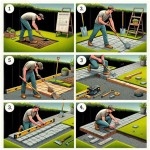How to Build Patio Steps From Pavers
Creating a set of patio steps from pavers is a rewarding DIY project that adds functionality and beauty to your outdoor space. Pavers offer versatility in design, durability, and ease of installation. This guide will outline the steps involved, from planning and materials to construction and finishing touches.
1. Planning and Design
Before starting, carefully plan the design and layout of your paver steps. Consider these factors:
- Location: Choose a suitable spot for your steps, ensuring the ground is level and stable.
- Height: Determine the desired height of each step. Aim for a comfortable rise of 6-8 inches for safe accessibility.
- Width: Decide on the width of each step, considering the size of your patio and the flow of traffic.
- Style: Select a paver style, color, and pattern that complements your existing patio and landscaping.
- Material: Concrete pavers are a popular choice for their durability and affordability. Other options include stone, brick, or recycled materials.
It's helpful to create a sketch or diagram of your planned design, including dimensions and material choices. This will assist in visualizing the final outcome and calculating the required materials.
2. Preparing the Site
Proper site preparation is crucial for a solid and stable foundation for your paver steps. Follow these steps:
- Clear the Area: Remove any existing vegetation, debris, or obstacles from the designated area.
- Dig the Trench: Excavate a trench for each step, ensuring proper depth and width to accommodate the pavers and a base layer of gravel.
- Level the Base: Compact the bottom of the trench with a tamper or compactor to create a firm, level base. This prevents settling and ensures even step surfaces.
- Add Gravel: Place a layer of compacted gravel (4 inches deep) in the trench. This provides drainage and a solid base for the pavers.
- Install Landscape Fabric: Cover the gravel layer with landscape fabric to prevent weeds from growing through the gaps in the pavers.
Ensuring a level and stable base is essential for long-lasting and safe steps. Utilize a level and measuring tape to check for accuracy throughout the preparation process.
3. Installing the Pavers
Once the site is prepared, begin installing the pavers. This process involves careful placement, leveling, and securing.
- Lay the First Row: Start with the bottom step, laying the pavers in a pattern of your choice. Use a level to ensure each paver is perfectly level.
- Use Paver Sand: Fill the gaps between the pavers with paver sand, compacting it with a brush or tamper to create a solid bond and prevent shifting.
- Create the Edging: Install paver edging around the perimeter of each step for a clean and defined look. Use landscaping staples, spikes, or mortar to secure the edging.
- Continue Upwards: Repeat the process for each subsequent step, ensuring proper alignment and leveling.
- Install a Landing: If desired, create a landing area at the top of the steps using additional pavers. This provides a flat surface for transitioning onto your patio.
Allow the paver sand to settle for a day or two before applying additional sand or mortar to fill any gaps. This will create a durable and aesthetically pleasing finish.
4. Finishing Touches
After the initial installation is complete, add the finishing touches to enhance the appearance and longevity of your paver steps.
- Apply Polymeric Sand: For added stability and weed prevention, apply polymeric sand between the pavers. This material hardens and creates a durable, water-resistant surface.
- Clean Up: After the sand has set, thoroughly clean the pavers and surrounding area, removing any excess sand or debris.
- Add Landscaping: Optional landscaping elements like plants, shrubs, or lighting can enhance the overall appearance of your paver steps and blend them seamlessly with your patio and garden.
Regular maintenance, such as sweeping away debris and applying a sealant every few years, will help keep your paver steps looking their best for years to come.

How To Build A Stone Step For Your Raised Patio Western Interlock

How To Build Paver Patio Steps Doityourself Com

How To Use Stone Pavers Build Steps Rels

Paver Step Replacing Concrete Steps Avoiding Shifting

Paver Steps Landings Chicagoland Hardscapes By Design Pavers

Make Steps From Paver Blocks Patio Stairs Outdoor

We Show The Way Construct Steps Using Wall Stones With Photos Descriptions Newtown Square Pa From Robert J Kleinberg Landscape Design

Paver Step Replacing Concrete Steps Avoiding Shifting

Gradino Step Block The Simple Paver Western Interlock

Step Building No Nos
Related Posts








